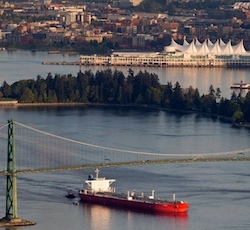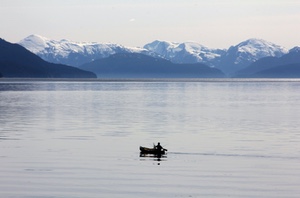British Columbia has been a hotspot of concern—and research—about the extent and the impacts of shipping noise. The southern BC coast is close to acoustic saturation, with any increase in noise having the potential to completely overwhelm the underwater soundscape; meanwhile the northern coast holds a few areas that are still nearly free of human noise intrusion, and we need to do all we can to preserve these increasingly rare acoustic refuges. These contentious waters have been roiled in several contradictory though perhaps ultimately productive ways by recent Canadian government actions. In the month between Thanksgiving and Christmas, a northern pipeline was rejected and a southern one approved; meanwhile, ongoing research aims to identify the noisiest ships and help inform new regulations that could reduce overall noise levels.
 The biggest headlines and fears have been spurred by the final approval of the Trans Mountain Pipeline expansion that will deliver oil from the Alberta tar sands to an existing port in Burnaby, BC. The port currently hosts about five tankers a month; the increased flow in the expanded pipeline (75% the capacity as the proposed Keystone XL) will necessitate about 35 ships a month, meaning an average of two tanker transits a day past Vancouver as they travel to and from the Strait of Georgia off the coast. These waters are currently burdened by shipping noise 85% of the time, and the increased traffic will push this to 100% in some areas. Concern centers on the tenuous status of the region’s orca populations, which are struggling to find the salmon they need; shipping noise makes it harder for them to track salmon with their echolocation clicks and to communicate with each other as they search for food. “Death by a thousand cuts, and this is a very deep cut,” says Deborah Giles, research director for the Center for Whale Research. “They’re spending more energy to find less food and we’re adding the equivalent of a rock concert,” she says. “These whales will not survive.”
The biggest headlines and fears have been spurred by the final approval of the Trans Mountain Pipeline expansion that will deliver oil from the Alberta tar sands to an existing port in Burnaby, BC. The port currently hosts about five tankers a month; the increased flow in the expanded pipeline (75% the capacity as the proposed Keystone XL) will necessitate about 35 ships a month, meaning an average of two tanker transits a day past Vancouver as they travel to and from the Strait of Georgia off the coast. These waters are currently burdened by shipping noise 85% of the time, and the increased traffic will push this to 100% in some areas. Concern centers on the tenuous status of the region’s orca populations, which are struggling to find the salmon they need; shipping noise makes it harder for them to track salmon with their echolocation clicks and to communicate with each other as they search for food. “Death by a thousand cuts, and this is a very deep cut,” says Deborah Giles, research director for the Center for Whale Research. “They’re spending more energy to find less food and we’re adding the equivalent of a rock concert,” she says. “These whales will not survive.”
Environmental groups will likely file suit challenging the approval, citing the government’s failure to mitigate the increased impact. At the same time, though, Fisheries Minister Dominic LeBlanc and Transport Minister Marc Garneau are working on a revamped recovery plan for the 80 remaining resident orcas. LeBlanc notes that “Certain ships emit more noise than others, certain kinds of propellers and other things in the water are noisier than others. There is an engineering and a scientific way that the noise can be limited by regulation. We would hope to get to a circumstance where there would be no net increase in the noise — in spite of the potentially increased tanker traffic.” While stressing that the impacts of noise are clearly important, LeBlanc stresses that tanker traffic “is a tiny fraction of the total marine traffic that has existed for a long time.” Ferries appear to be the focus of the government planning. “Given that the highest vessel traffic is from ferries,” Garneau adds, “we will be also be working with BC Ferries on possible approaches that will help us achieve our objectives.”
A newly deployed acoustic monitoring station may help them do just that. In October, Ocean Networks Canada placed a 450 kg (1000 lb) “underwater listening station” on the floor of the Strait of Georgia, updating and expanding a research project that began a year earlier. Tom Dakin of ONC said the hydrophone array can tell if there are maintenance problems creating excessive noise, such as rope wrapped around a propeller shaft. “In some cases, we can tell them specifically what maintenance to do. There’s a lot of variability in the ships.” Dakin elaborates:
“I’ve been in the water in Active Pass when two vessels went by, generating about 180 decibels, ” he said. “It felt like someone was hitting me in the chest with a two-by-four. Thump, thump, thump. A lot of energy in the water.”
…
Two B.C. Ferries ships, Queen of Alberni and Coastal Inspiration, produce much of the underwater noise in the area because they regularly move passengers between Tsawwassen and Duke Point, near Nanaimo, he said. “They’re the two most measured vessels in the world right now,” he said. “How does the noise vary with their load, speed, weather conditions and currents? All that plays into how much noise the ship generates.” With greater study, officials might be able to recommend, say, a slower speed under certain conditions to reduce noise. “This next year will provide a lot more information,” Dakin added.
Environmental advocates are dubious that this research and the new recovery plan will be able to neutralize the impact of increased tanker traffic, at least in the near-term. “I’m really curious on how — within the next year or two — they’re going to mitigate,” said Misty MacDuffee, a biologist with the Raincoast Conservation Foundation, “Because mitigation means (retro)fitting and redesigning vessels.” In the meantime, she emphasizes, “If you can’t mitigate effects on an endangered population, your project cannot proceed. So we’re saying that this is unlawful.”
 The news was far better for marine populations living in those precious pockets of northern BC where the ocean’s natural soundscapes still dominate. In late November, the Trudeau administration killed the long-dreaded Northern Gateway pipeline from the oil sands to a port deep inside a remote fjord (see image at right); the pipeline was approved by the prior government in 2014 but overturned by the courts earlier this year. Even better, Canadian authorities are promising a ban on any crude oil tankers along the northern BC coast. A moratorium is expected to be announced very soon, with legislation backing a permanent ban to be introduced in spring.
The news was far better for marine populations living in those precious pockets of northern BC where the ocean’s natural soundscapes still dominate. In late November, the Trudeau administration killed the long-dreaded Northern Gateway pipeline from the oil sands to a port deep inside a remote fjord (see image at right); the pipeline was approved by the prior government in 2014 but overturned by the courts earlier this year. Even better, Canadian authorities are promising a ban on any crude oil tankers along the northern BC coast. A moratorium is expected to be announced very soon, with legislation backing a permanent ban to be introduced in spring.
